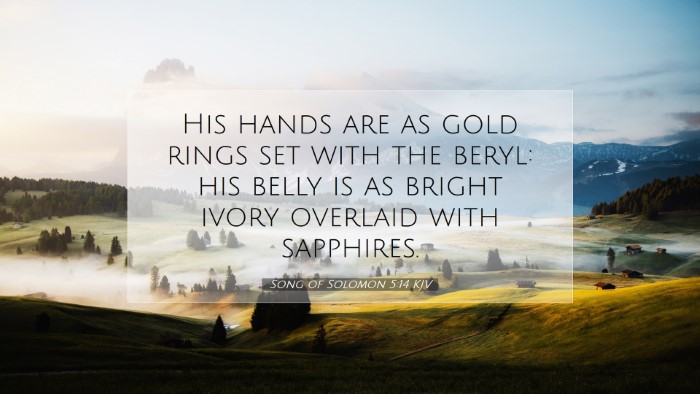Commentary on Song of Solomon 5:14
Song of Solomon 5:14 states:
"His hands are as gold rings set with the beryl: his belly is as bright ivory overlaid with sapphires."
Introduction
This verse is part of a highly poetic and metaphorical text found in the Song of Solomon, which is traditionally attributed to King Solomon. The language used in this book is rich in symbolism and allusion, making it a favorite for literary and theological analysis.
Exegesis and Interpretation
The imagery presented in this verse provides a captivating insight into the subject of desire and beauty. The text speaks to the aesthetic qualities of the beloved, emphasizing both physical appearance and deeper symbolic meanings.
Imagery and Symbolism
-
Gold Rings Set with Beryl:
Matthew Henry interprets the 'gold rings' as depicting purity and preciousness, suggesting that the beloved's hands are not only beautiful but also signify a wealth of grace and virtue. The ring itself is a symbol of covenant and commitment, enhancing the theme of love and union.
-
Belly as Bright Ivory:
Albert Barnes comments that the reference to 'ivory' carries connotations of value and rarity, suggesting an inherent dignity. Ivory, as a material, is often associated with nobility, and the beauty here reflects the emotional and spiritual richness of the beloved.
-
Overlay with Sapphires:
Adam Clarke elevates the sapphire imagery to denote spiritual depth and wisdom. The use of precious stones enhances the overall impression of beauty and indicates that the beloved is not merely attractive in a superficial way, but embodies valuable qualities that are deeply admired.
Thematic Connections
Throughout the Song of Solomon, we find themes of love, longing, and the celebration of human beauty. This verse perfectly encapsulates how physical beauty can reflect inner qualities, thus serving as an invitation to engage with the whole person beyond mere externality.
Love and Beauty
The Song of Solomon speaks profoundly about romantic love. This particular verse illustrates the interplay between physical attraction and deeper emotional and spiritual connection. The descriptions serve to elevate the beauty of the beloved while simultaneously drawing attention to the qualities that define and elevate that beauty.
Spiritual Metaphor
Many theologians interpret the entire text of the Song of Solomon as an allegory of God’s relationship with Israel, and by extension, Christ's love for the Church. In this light, the attributes ascribed to the beloved can be seen as reflective of divine beauty and grandeur. The 'hands' and 'belly' can be viewed as metaphors for divine actions and sustenance—bringing both creativity and nurture.
Application for Today
For pastors, students, and theologians, the vivid portrayals within this verse can provoke a thoughtful response to essential questions about love and beauty in our own lives and communities. How do we perceive beauty? Are we drawing connections between the physical and the spiritual in our relationships?
Encouragement to Pursue Inner Beauty
This verse serves as a reminder that while physical beauty may capture our initial attention, it is the inner beauty characterized by virtues such as grace, kindness, and love that lasts beyond time. Pastors might encourage their congregations to embrace this holistic view of beauty, aiding individuals to value character over mere appearance.
Reflective Practice
The artistic imagery invites personal reflection; readers are encouraged to contemplate what it means to find beauty and desirability in themselves and others. This poetic exploration promotes a deeper understanding of relationships modeled after divine love—calling individuals to cultivate their spiritual qualities which reflect God’s image.
Conclusion
In summary, Song of Solomon 5:14 encapsulates the beauty of love in its multifaceted form. The emphatic descriptions of the beloved invoke a response of admiration and reflect a deeper narrative of love’s worth and depth. Both in the context of human relationships as well as the divine, these insights provide rich material for reflection and study, advocating for a holistic understanding of beauty that transcends the physical.


